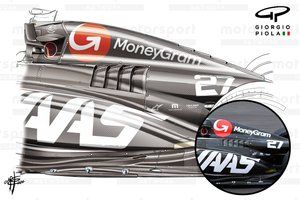What’s behind Alpine's jumbo airbox
Alpine caused a stir on the opening day of Formula 1 testing when it emerged with a rather exaggerated mega airbox and engine cover.

Photo by: Charles Coates / Motorsport Images
With the modern trend being for teams to try to shrink wrap the bodywork around the power unit components, Alpine’s solution is unique and something we were more used to seeing in the 1970’s.
But the first thing to say is that the airbox and roll over structure of the A521 has not changed if we compare it with the RS19 or RS20. Instead, it’s the bodywork behind that’s been significantly increased in size.

Alpine A521 cover
Photo by: Alpine

Renault R.S.20
Photo by: Renault
The reasoning for this, although it might sound odd at first, is predominantly to mitigate the incoming regulation changes that narrow the floor and rear brake ducts and see the lower portion of the diffuser strakes lopped off.
Whereas the rest of the grid have pushed-on and developed the downwash style sidepod arrangement which generally results in the airflow running over the top of the sidepod and meeting with the floor as quickly as possible, the A521 has an arrangement more akin to what teams used in the pre-hybrid era.
This is for a more heavily undercut frontal section and higher waisted sidepod along the entire length.

Esteban Ocon, Alpine A521
Photo by: Mark Sutton / Motorsport Images
This creates more space between the sidepod and the floor in order that the team deals with the issues created by the new regulations in its own unique way.
However, to achieve its aerodynamic goals, the team had to rethink the cooling architecture of the car, resulting in the radiators and other hardware housed within the sidepods having to be repositioned.
The arrangement that Renault has run in previous years has already seen a great deal of that hardware packed in around the power unit due to the makeup of its cooling package. But with even more hardware to deal with, the region has increased quite dramatically in size.

Renault F1 Team R.S.19 powerunit install
Photo by: Mark Sutton / Motorsport Images
So, in essence, the changes are driven by the regulation changes and are simply Alpine’s way of dealing with these issues, whilst trying to recover as much performance as possible, without damaging the car’s overall performance envelope.
Irrespective of the genuine technical reasoning behind the changes, it’s easy to draw comparisons with a variety of different airbox and engine cover solutions in Formula 1’s past...
Be part of the Autosport community
Join the conversationShare Or Save This Story
Related video
Subscribe and access Autosport.com with your ad-blocker.
From Formula 1 to MotoGP we report straight from the paddock because we love our sport, just like you. In order to keep delivering our expert journalism, our website uses advertising. Still, we want to give you the opportunity to enjoy an ad-free and tracker-free website and to continue using your adblocker.
























Top Comments